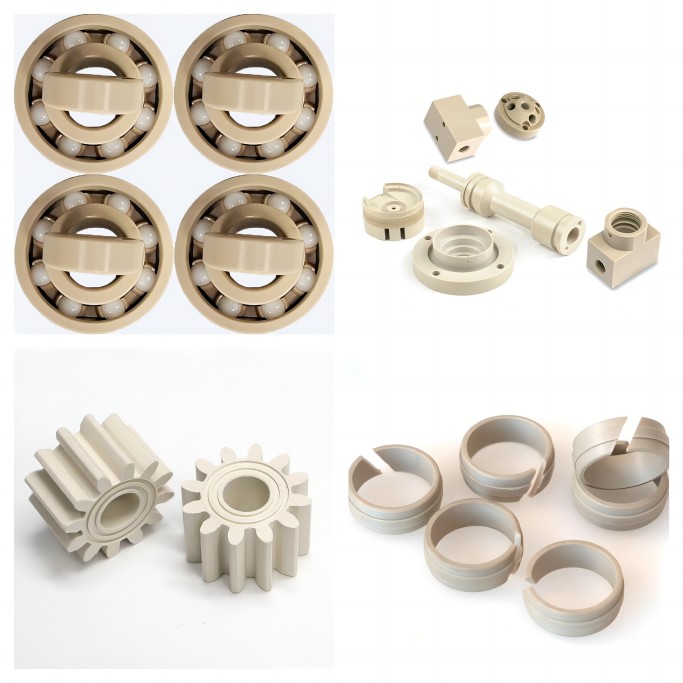
Privacy statement: Your privacy is very important to Us. Our company promises not to disclose your personal information to any external company with out your explicit permission.
In recent years, the application of special engineering plastics has gradually extended from the previous military and aerospace fields to more and more civilian fields, such as automotive, equipment manufacturing, high-end consumer goods. Among them, Polyphenylene Sulfide (PPS) and polyether ether ketone (PEEK) are two types of special engineering plastics with rapid development and a wide range of applications.
The application of special engineering plastics has been gradually extended from the previous military and aerospace fields to more and more civilian fields, such as automotive, equipment manufacturing, high-end consumer goods and so on. Among them, polyphenylene sulfide (PPS) and polyether ether ketone (PEEK) are two types of special engineering plastics with rapid development and a wide range of applications.In this Blog we examine the characteristics and differences between the two types of materials, which can be considered according to your own product's working conditions, performance requirements and cost budget.

PEEK Vs. PPS : The Equal Characters
Both PEEK and PSS are semi-crystalline, high-performance thermoplastics that are well suited to applications involving bearings (and are available in bearing grades with additives to further improve their performance), bushings and seals. You can find both materials in many different industries, including oil and gas, food and dairy, and medical implants. In fact, both have FDA-approved grades with the following properties:
1) Good chemical compatibility
2) Low friction
3) Good resistance to fatigue cracking
4) Excellent wear resistance
Both PEEK and PPS are flame retardant, which is important for some applications, and resistant to steam and hot water. Both materials are also dimensionally stable, have a low moisture absorption coefficient, similar coefficients of thermal expansion and very good dielectric properties. In addition, both PEEK and PPS can be machined, injection moulded or moulded, with a choice of how to manufacture PEEK or PPS parts.
PEEK Vs. PPS : The Different Characters
PEEK is superior to PPS in terms of strength, toughness, maximum working temperature, etc. In terms of high temperature resistance, PEEK's temperature resistance is about 50°C higher than that of PPS. On the other hand, the relatively obvious cost advantage of PPS and better processing performance make it more widely used.
The first major difference between PEEK and PPS that limits interchangeability is the maximum operating temperature: PEEK has a maximum continuous operating temperature of 480°F, while PPS is 430°F. This means that PPS is limited to environments and applications where the operating temperature stays below 430°F. The PV limit for PPS is lower than for PEEK, which means that some bearing applications with high PV values may be limited to PEEK. PPS has a lower PV limit than PEEK, which means that some bearing applications with high PV values may be limited to PEEK .
PEEK has slightly higher tensile strength, while PPS has better compressive strength PEEK also has higher cantilever beam notched impact strengths ranging from 1.5 to 2.2 ft-lb/in (depending on grade) for PEEK and 0.38 to 1.5 ft-lb/in for PPS While PEEK and PPS have similar chemical resistance, PPS is the better choice of the two and has no known solvents below 400°F. While PEEK and PPS have similar chemical resistance, PPS is the better of the two and has no known solvents below 400°F.
The main difference between PEEK and PPS is cost: PPS is much cheaper than PEEK, making it the material of choice for applications that don't involve extreme temperatures, and when high temperatures aren't involved, PPS quickly becomes a much more attractive option than PEEK because it has similar mechanical and thermal properties to PEEK, but at a much lower cost. pps may actually offer better chemical compatibility, although its PV limits and strength may be better. PPS may actually offer better chemical compatibility, although its PV limits and strength may be lower. So, in short, before you decide to make PEEK your material of choice, find out if PPS is really right for your design and a more economical option.
HONY plastic : Your Source for High-Performance Plastic Parts
At HONY Plastic, we have been machining high-quality PPS and PEEK parts with tight tolerances for decades. We have the equipment and expertise to provide you with superior plastic parts in a timely manner. For more information about our capabilities or to request a quote to sales@honyplastic.com

November 17, 2024
November 16, 2024
August 27, 2021
August 26, 2021
PEEK ball is a special type of ball made of polyether ether ketone (PEEK), which has excellent chemical stability, abrasion resistance, and high temperature resistance.PEEK ball is widely used in...
PVDF Application Areas Different models of PVDF products are suitable for different application scenarios. According to application fields, PVDF can be divided into conventional grade products and...
Application Performance Advantages of MC nylon MC nylon is a new type of engineering plastics, due to its outstanding comprehensive performance, so that its status in engineering plastics is rapidly...
Types of nylon: 1. Nylon - 6 (PA6) Nylon -6, also known as polyamide -6, that is, polycaprolactam. Translucent or opaque opalescent resin. 2. Nylon - 66 (PA66) Nylon-66, also known as polyamide-66,...
Email to this supplier
November 17, 2024
November 16, 2024
August 27, 2021
August 26, 2021

Privacy statement: Your privacy is very important to Us. Our company promises not to disclose your personal information to any external company with out your explicit permission.

Fill in more information so that we can get in touch with you faster
Privacy statement: Your privacy is very important to Us. Our company promises not to disclose your personal information to any external company with out your explicit permission.